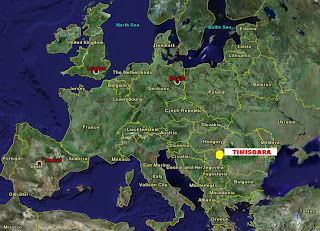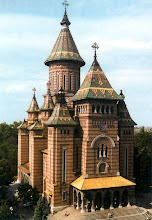 Municipiul Timisoara este asezat la intersectia paralelei de 45°47’ latitudine nordica, cu meridianul de 21°17’ longitudine estica, aflandu-se, ca pozitie matematica, in emisfera nordica, la distante aproape egale de polul nord si de ecuator si in emisfera estica, in fusul orar al Europei Centrale. Ora locala a orasului (considerata dupa meridian) este in avans cu 1h 25’ 8’’ fata de ora meridianului 0, Greenwich, dar se afla in intarziere cu 34’52’’ fata de ora oficiala a Romaniei (ora Europei Orientale). Municipiul Timisoara se afla situat la o distanta medie de aproximativ 550 km fata de capitala Romaniei - Bucuresti si cca.170 km si 300 km fata de Belgrad si Budapesta, capitalele celor doua tari invecinate Serbia-Muntenegru si respectiv Ungaria.
Municipiul Timisoara este asezat la intersectia paralelei de 45°47’ latitudine nordica, cu meridianul de 21°17’ longitudine estica, aflandu-se, ca pozitie matematica, in emisfera nordica, la distante aproape egale de polul nord si de ecuator si in emisfera estica, in fusul orar al Europei Centrale. Ora locala a orasului (considerata dupa meridian) este in avans cu 1h 25’ 8’’ fata de ora meridianului 0, Greenwich, dar se afla in intarziere cu 34’52’’ fata de ora oficiala a Romaniei (ora Europei Orientale). Municipiul Timisoara se afla situat la o distanta medie de aproximativ 550 km fata de capitala Romaniei - Bucuresti si cca.170 km si 300 km fata de Belgrad si Budapesta, capitalele celor doua tari invecinate Serbia-Muntenegru si respectiv Ungaria.
--------- ------------ ------------ ----------- ----------- -----------
Timisoara is located at the intersection of parallel 45 ° 47 'north latitude with the meridian 21 ° 17' east longitude, is located as mathematics position in the northern hemisphere, to almost equal distances from the north pole and the equator in the hemisphere east, in the time zone of Central Europe. Local Time city (considered by meridian) in advance 1h 25 '8''from time 0 meridian, Greenwich, but was late with 34'52''from the official time of Romania (East European Time).
Timisoara is located at an average distance of approximately 550 km from the capital of Romania - Bucharest and cca.170 km and 300 km from Belgrade and Budapest, the capital cities of the two countries to Serbia-Montenegro and Hungary respectively.
Asezare Geografica a Timisoarei
Timisoara este situata in sud-estul campiei Tisei, in zona de divagare a raurilor Timis si Bega. Apele celor doua rauri au format aici un tinut foarte mlastinos si frecvent inundat. Timisoara insa s-a dezvoltat intr-unul din putinele locuri pe unde se puteau trece mlastinile.
Acestea au constituit pentru mult timp o autentica fortificatie in jurul cetatii, insa au favorizat si o atmosfera umeda si insalubra, precum si proliferarea epidemiilor de ciuma si holera, care au mentinut relativ scazut numarul de locuitori si au impiedicat semnificativ dezvoltarea cetatii.
Cu timpul insa intreaga zona a fost bonificata, paienjenisul de canale au fost deviate, mlastinile s-au uscat. Decisiv pentru imbunatatirea terenului a fost construirea Canalului Bega incepand cu 1728 si asanarea completa a mlastinilor din imprejurimi. In schimb, terenul de pe raza orasului mosteneste o panza freatica aflata la o adancime de numai 0,5 - 5 m: factor care nu permite construirea edificiilor inalte.
Timisoara detine cel mai amplu ansamblu de cladiri istorice din Romania.
------ ------ ------- -------- -------- ------- ------ ------ ------ ----- ------
Geographic position of Timisoara
Timisoara is situated in south-eastern plain Tisza, in the ramble of the rivers Timis and Bega. The waters of the two rivers formed here held a very sloppy and frequently flooded. Timisoara but has developed into one of the few places where you could go marshes.
They were for a genuine long fortification around the fortress, but favored a wet and dirty atmosphere, and the proliferation of epidemics of plague and cholera, which have maintained relatively low number of inhabitants and prevented significant development of the fortress.
But with time the area was subsidy, cobweb channels were diverted, marshes have dried. Decisively to improve the land has been building since Bega Channel 1728 and complete improvement of the surrounding marshes. Instead, the land of the city radius inherits a groundwater aquifers at the depth of only 0.5 - 5 m: factor which does not allow building high buildings.
Timisoara has the most comprehensive set of historic buildings in Romania.
Timisoara - Primul oras liber
In data de 16 decembrie 1989 la Timişoara s-a declanşat revoluţia care avea să ducă la înlăturarea lui Nicolae Ceausescu şi a regimului comunist din România. Iniţial s-a format o mişcare de protest împotriva mutării forţate a pastorului reformat Laszlo Tokes. Atât enoriaşi cât şi trecători s-au adunat în faţa parohiei acestuia în semn de protest. La scurt timp însă, protestul s-a transformat într-unul împotriva întregului sistem şi s-au scandat pentru prima dată lozinci anticomuniste. Mişcarea a luat rapid amploare şi în centrul oraşului s-au adunat zeci de mii de revoluţionari. Pe 20 decembrie 1989, Timişoara a fost declarată primul oraş din România liber de comunism, în urma unor confruntări sângeroase soldate cu peste 1000 de morţi şi alte câteva mii de răniţi. Aceste evenimente au dus la căderea regimului ceauşist o săptămână mai târziu.
----- ----- ----- ----- ----- ----- ------ ------ ---
On 16 December 1989 in Timisoara began the revolution which would lead to the removal of Nicolae Ceausescu and the communist regime in Romania. Initially formed a movement of protest against the forced relocation of Reformed Pastor Laszlo Tokes. Both sheep and parade were gathered in front of the parish in protest. Soon however, the protest turned into one against the entire system and scandal were first anti catchphrase. The movement took the large and rapidly downtown have gathered tens of thousands of revolutionary. On 20 December 1989, Timişoara was declared first city in Romania free of communism, after bloody confrontations resulted in over 1,000 dead and thousands injured. These events led to the fall of Ceausescu regime a week later.
Timisoara has the most comprehensive set of historic buildings in Romania.

